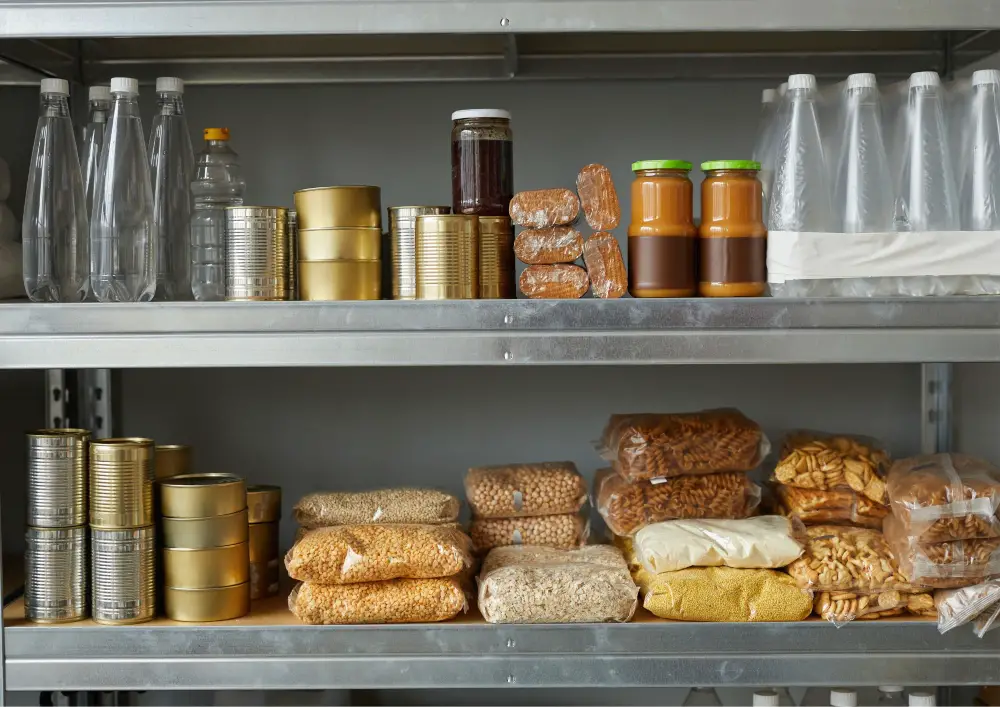In the realm of kitchen organization and efficiency, a well-designed pantry stands as a cornerstone. The pantry is not merely a storage space; it’s a functional hub that can streamline meal preparation, enhance accessibility, and contribute to an overall organized kitchen environment.
In this exploration, delve into the art and science of pantry layout designs, uncovering ingenious ways to maximize space, optimize storage, and elevate the functionality of this essential culinary haven.
Uncover and illuminate ingenious strategies aimed at not only maximizing your pantry layout but also optimizing efficiency. Brace yourself for an insightful exploration that seeks to elevate the functionality of this essential culinary haven, transforming it into a harmonious blend of practicality and aesthetic brilliance.
Contents
Understanding the Significance of Pantry Layouts
Before delving into specific pantry layout designs, it’s crucial to comprehend the significance of a well-organized pantry. The pantry is a repository for various kitchen essentials, including dry goods, canned items, spices, and even kitchen gadgets.

A thoughtfully designed pantry layout not only accommodates these items but also ensures easy access, efficient organization, and an aesthetically pleasing space.
In the realm of pantry layout, every decision made contributes to the overall functionality and visual appeal. By prioritizing the elements of a purposeful pantry layout, you pave the way for an environment where the term “pantry layout” becomes synonymous with a harmonious blend of practicality and design excellence.
Key Elements of a Smart Pantry Layout
1. Shelving Strategies
- Adjustable Shelving: Embrace flexibility with adjustable shelving to accommodate items of varying heights. This ensures that the space is utilized efficiently, preventing wasted vertical space.
- Pull-Out Shelves: Integrate pull-out shelves for easy access to items stored in the back. This minimizes the need for reaching or rummaging through deep shelves.
2. Zone-Based Organization
- Categorization: Organize pantry items into zones based on categories such as baking essentials, canned goods, snacks, and condiments. This helps streamline the cooking and meal planning process.
- Cooking Zone: Dedicate a section for frequently used cooking supplies, spices, oils, and sauces nearby for quick and efficient meal preparation.
3. Storage Containers and Baskets
- Uniform Storage Containers: Opt for uniform storage containers to create a cohesive and visually appealing look. Clear containers also allow for easy visibility, helping you keep track of inventory.
- Basket Systems: Implement baskets for grouping similar items. These can be easily pulled out for a quick visual inventory and look neat and organised.
4. Utilizing Door Space
- Door-Mounted Shelves: Maximize door space by adding shelves or racks. This is an excellent area for storing spices, small condiments, or even kitchen tools, freeing up valuable shelf space.
- Over-the-Door Organizers: Consider over-the-door organizers for additional storage. These can hold everything from snacks to cleaning supplies, making the most of vertical space.
5. Pull-Out Drawers and Trays
- Roll-Out Drawers: Integrate roll-out drawers for easy access to items stored at lower levels. This is particularly beneficial for deep pantry shelves, preventing items from getting lost in the back.
- Tray Dividers: Incorporate tray dividers for baking sheets, cutting boards, or serving trays. This keeps these items upright and easily accessible with less cluttering on other shelves.
Pantry Layout Designs: Making Every Inch Count

1. The L-Shaped Pantry
Ideal for corner spaces, the L-shaped pantry maximizes storage along two adjacent walls. This design allows ample shelving, with corner shelving or lazy Susans optimizing hard-to-reach corners.
Recognizing the challenge posed by hard-to-reach corners, the L-shaped pantry introduces strategic corner shelving solutions. These may include custom-designed corner shelves, pull-out trays, or rotating mechanisms, ensuring that every inch of space is utilized effectively.
Benefits: Efficient use of corner space, easy access to items, and a visually cohesive layout.
2. Walk-In Pantry With Zones
For larger kitchens, a walk-in pantry with designated zones takes the organization to the next level. Different areas can be allocated for dry goods, beverages, snacks, and even small appliances. Designated zones signify a significant advancement in organizational efficiency. This meticulously planned pantry design transcends the conventional concept of storage, ushering in a systematic and strategic approach where specific areas are allocated for various categories of items.
The walk-in pantry, a spacious haven for culinary essentials, not only provides ample room but also elevates the level of organization to cater to the diverse storage needs inherent in a generously proportioned culinary space.
Benefits: Spacious and highly organized, providing a comprehensive storage solution for various kitchen items.
3. Pull-Out Pantry
A pull-out pantry is a narrow, vertical space typically located between cabinets or appliances. It features shelves or drawers that can be pulled out, providing easy access to stored items.
Distinguished by its innovative design, This functional and stylish feature is specifically crafted to optimize space utilization and enhance the overall efficiency of a kitchen.
Benefits: Perfect for tight spaces, offers efficient use of vertical space, and ensures items are readily accessible.
4. Butler’s Pantry
Traditionally located between the kitchen and dining room, a modern Butler’s pantry is a multifunctional space for storing dishes, servingware, and even wine. It often includes counter space for meal staging.
Positioned traditionally between the kitchen and dining room, the modern Butler’s pantry transcends its historical role, serving as a sophisticated hub. An essential feature of this updated space is the incorporation of ample counter space, transforming it into a practical area for meal staging and additional culinary activities.
Benefits: Adds elegance to the home, provides additional storage and serves as a staging area for entertaining.
5. Under-Stair Pantry
Utilizing the space under a staircase, this pantry design cleverly transforms an often-overlooked area into a functional storage solution. Shelves or pull-out drawers can be installed to maximize the available space. By capitalizing on the unique architecture of the staircase, shelves or pull-out drawers can be seamlessly incorporated to optimize the available space, turning it into a versatile storage haven.
Benefits: It makes efficient use of otherwise unused space, ideal for smaller homes or apartments.
Implementing a Successful Pantry Layout

1. Assess Your Storage Needs
Before designing your pantry layout, assess the types and quantities of items you need to store. This will guide the shelving and storage solutions you implement. Designated zones signify a significant advancement in organizational efficiency.
2. Prioritize Accessibility
Arrange frequently used items at eye level or within easy reach. Reserve lower and higher shelves for items that are accessed less frequently.
3. Consider Lighting
Ensure your pantry is well-lit to enhance visibility. LED strip lights or motion-activated lights can be installed for optimal illumination.
4. Labeling System
Implement a labelling system for bins, containers, and shelves. This not only enhances organization but also makes it easier to locate specific items.
5. Regular Upkeep
Schedule regular upkeep sessions to declutter and reorganize your pantry. Take note of items nearing expiration and adjust your shopping list accordingly.
Designing the Ultimate Storage Space
1. Roll-Out Trays for Deep Shelves
If your pantry has deep shelves, install roll-out trays or sliding shelves. These mechanisms allow you to access items at the back of the shelves by not having to reach or move other items, improving overall accessibility.
2. Chalkboard or Whiteboard Panels
Install chalkboard or whiteboard panels on the inside of pantry doors. Use these panels to jot down shopping lists, meal plans, or notes, adding a practical and organized touch to your pantry.
3. Bottle and Can Organizers
Utilize vertical space by incorporating organizers specifically designed for bottles and cans. These organizers prevent items from tipping over and make it easy to see and access your collection.
4. Pantry Door Shelving
Maximize the space on the inside of your pantry door by adding shelves or organizers. This is an excellent spot for storing spices, condiments, or small items, keeping them within reach and well-organized.
5. Pull-Out Baskets or Bins
Consider adding pull-out baskets or bins to your pantry shelves. These are great for storing potatoes, onions, or other produce, allowing for proper ventilation and easy access.
6. Utilize Clear Containers
Store dry goods in clear containers. This not only keeps your pantry looking uniform but also allows you to quickly identify the contents and monitor when it’s time to restock.
7. Pantry Mirror
Install a small mirror inside the pantry door. This not only serves a practical purpose but can also create the illusion of more space and light within the pantry.
8. Hanging Hooks for Bags and Utensils
Install hooks on the inside of your pantry door or on the walls for hanging reusable bags, aprons, or kitchen utensils. This helps declutter the shelves and keeps frequently used items easily accessible.
9. Smart Shelving Heights
Adjust the height of your shelves based on the items you store. Reserve taller spaces for cereal boxes or large items, while shorter spaces can accommodate jars and smaller containers. This ensures efficient use of space.
By incorporating these additional tips into your pantry design, you can create a space that is not only organized and functional but also tailored to your specific storage needs and preferences.
By implementing these considerations, your smart pantry layout becomes a reflection of your unique preferences, providing a harmonious blend of functionality, accessibility, and aesthetic appeal within your kitchen space.
Key Factors to Consider
Designing the ideal pantry layout involves thoughtful consideration of various factors to ensure functionality, accessibility, and aesthetics. Be sure to be able to determine the right pantry layout for your kitchen.

1. Assessing Your Storage Needs
Begin by taking stock of the items you regularly use in your kitchen. Categorize and assess the types and quantities of dry goods, canned items, kitchen tools, and appliances that require storage. Understanding your storage needs is fundamental to creating a layout that accommodates all essentials.
2. Considering Available Space
Evaluate the designated space for your pantry. Measure the dimensions, including height, width, and depth. This step is crucial in determining the type of pantry layout that fits within the available space. Consider whether a walk-in pantry, a reach-in pantry, or a built-in cabinet pantry suits your kitchen dimensions.
3. Analyzing Your Cooking Habits
Reflect on your cooking routines and habits. Consider how frequently you access different items and the flow of your culinary activities. This analysis helps in organizing the pantry layout to align with the natural rhythm of your cooking, ensuring easy access to essential supplies.
The Wrap Up: Elevating Your Culinary Haven
A well-designed pantry layout is a game-changer in the realm of kitchen organization. It transforms a mere storage space into a functional and visually appealing hub that enhances your daily culinary endeavours.
Whether you opt for an L-shaped pantry, a walk-in marvel, or a cleverly tucked under-stair solution, the key lies in thoughtful organization, efficient use of space, and a layout that suits your lifestyle.
Investing time and creativity into your pantry layout is an investment in the efficiency and joy of your culinary journey. By implementing smart pantry layout designs, you’re not just maximizing space; you’re creating a harmonious and organized environment where every spice, and kitchen gadget has its place – making your kitchen a true culinary haven.
Are you ready to craft your smart pantry layout?
Frequently Asked Questions
1. Why is a well-designed pantry layout important for a kitchen?
A well-designed pantry layout is essential for efficient kitchen functionality. It ensures optimal organization, and easy access to items, and maximizes the use of available space.
2. How can you determine the right pantry layout for your kitchen?
Consider your storage needs, the size of your kitchen, and the types of items you regularly store. Customizing the layout to suit your lifestyle and cooking habits is key.
3. What are the key elements of an efficient pantry layout?
Key elements include adjustable shelving, pull-out drawers, proper lighting, and zones for different categories of items. These features enhance accessibility and organization.





